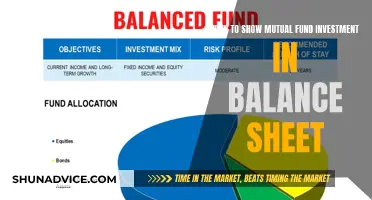
Mutual funds are a great way to invest in a diversified portfolio without the hassle and extra cost of choosing individual stocks. They are ideal for investors who don't have the time or ability to select stocks, as they allow you to leave the selection of individual stocks, bonds and other investments to professionals.
There are thousands of mutual funds to choose from, so it's important to have a checklist of factors to consider when deciding which to invest in. Here are some steps to get you started:
- Decide on your investment goals and time frame. Are you investing for the long term, for retirement, or do you have a shorter-term goal in mind, such as buying a home or a car? This will determine the level of risk you want to take.
- Pick the right mutual fund strategy. If you're investing for the long term, your mutual fund allocation should probably be mostly in stock-based mutual funds to maximise growth. If investing heavily in stocks makes you nervous, you may want to choose a balanced mutual fund that invests in both bonds and stocks to reduce risk.
- Research potential mutual funds. Use tools like the Mutual Fund Observer and Maxfunds to find detailed information on different mutual funds. Consider factors such as past performance, expense ratios and load fees.
- Open an investment account. If you have an employer-sponsored retirement plan such as a 401(k) or 403(b), you already have access to mutual funds. Otherwise, you can invest by opening a brokerage account.
- Purchase shares of mutual funds. Make sure you have enough money deposited in your investment account, bearing in mind that mutual funds may have higher investment minimums than other asset classes.
- Set up a plan to keep investing regularly. Decide how much and how often you will invest, and set up recurring investments so you don't have to remember to deposit money each time.
- Consider your exit strategy. You will eventually want to sell your mutual fund shares to pay for your financial goals, so think about whether you will need to pay any fees or taxes when you do so.
| Characteristics | Values |
|---|---|
| Investment goals | Long-term goals, mid-term goals, near-term goals |
| Investment strategy | Active funds, Passive funds |
| Investment research | Mutual Fund Observer, Maxfunds, brokerages' websites |
| Investment account | Individual retirement accounts (IRAs), taxable brokerage accounts, education savings accounts |
| Investment amount | Minimum investment of a few thousand dollars |
| Investment timing | Daily, weekly, monthly |
| Investment monitoring | Annually, quarterly, a couple of times a year |
| Investment advice | Robo-advisors |
What You'll Learn
- Understand the basics: Know what mutual funds are, how they work, and the different types available
- Set clear goals: Define your financial objectives and time horizon to guide your investment strategy
- Assess your risk tolerance: Determine how much risk you are comfortable with to help choose the right funds
- Research and compare: Evaluate different mutual funds based on factors like performance, fees, and fund management
- Choose an investment platform: Select a brokerage or financial advisor that suits your needs and goals

Understand the basics: Know what mutual funds are, how they work, and the different types available
Understand the Basics
Mutual funds are a type of investment vehicle that pools money from multiple investors to purchase a diverse range of securities, such as stocks, bonds, commodities, and even real estate. Each investor owns shares of the fund, representing a proportional interest in its underlying assets. Mutual funds are designed for long-term investors due to their high transaction costs. They offer the advantage of diversification, reducing the risk associated with individual investments.
Mutual funds are actively managed by fund managers, who conduct research and make investment decisions based on their chosen strategy. These professionals monitor the fund's performance and manage its risk exposure. The fund's investments can increase or decrease in value over time, impacting the returns generated for investors.
Types of Mutual Funds:
There are several types of mutual funds available, including:
- Bond Funds: These funds primarily invest in fixed-income securities, such as government or corporate bonds, and provide regular interest payments to investors.
- Stock Funds: Stock funds focus on investing in the stocks of various companies, aiming for long-term capital appreciation. They may target large-cap, mid-cap, or small-cap stocks and can be industry-specific.
- Balanced Funds: Balanced funds maintain a portfolio of both stocks and bonds, offering a mix of equity and fixed-income investments. The allocation between these asset classes can vary depending on the fund's strategy.
- Index Funds: Index funds aim to replicate the performance of a specific stock market index, such as the S&P 500. They are passively managed and have lower fees compared to actively managed funds.
Warren Buffett's Stance on Index Funds Explained
You may want to see also

Set clear goals: Define your financial objectives and time horizon to guide your investment strategy
Setting clear goals is the first step to investing in mutual funds. This means understanding your financial objectives, budget, and time horizon. Ask yourself: What are your short-term and long-term goals? How much money can you put toward your investment goals? And how much risk are you comfortable with?
For example, if your goal is to save for retirement, you may want to choose a more aggressive (stock-heavy) mutual fund. On the other hand, if you're saving for a shorter-term goal, like buying a home or a car, a bond market mutual fund might be a better option.
It's also important to evaluate your finances and be realistic about how much you can invest. This includes reviewing your income sources, establishing an emergency fund, and paying off any high-interest debts.
Once you have a clear understanding of your financial goals and budget, you can start to research and evaluate different mutual fund options to find the ones that best align with your objectives and risk tolerance.
Remember, investing in mutual funds is a long-term commitment, so it's crucial to set clear goals and choose funds that match your investment strategy.
- Investment goals: Are you saving for retirement, a down payment on a house, or something else? Be specific about your objectives and set a timeline for achieving them.
- Risk tolerance: How much risk are you comfortable with? This will depend on your financial cushion and investment horizon. Lower-risk investments include dividend stocks and bonds, while high-risk options include small-cap stocks and sector-specific investments.
- Investment strategy: Do you want to take a hands-on or hands-off approach? Mutual funds can be actively managed by professionals or passively managed through index funds or ETFs.
- Time horizon: How long do you plan to invest for? Longer time horizons typically allow for more aggressive investment strategies, while shorter time horizons may require a more conservative approach.
Closed-End Investment Funds: Where and How to Trade
You may want to see also

Assess your risk tolerance: Determine how much risk you are comfortable with to help choose the right funds
When it comes to investing, risk and reward are closely linked. All investments carry some degree of risk, and it's important to understand that you could lose some or all of your money. The potential for greater returns increases with the level of risk you're willing to take.
Your risk tolerance is the degree of risk you're comfortable with, and it's influenced by factors such as age, investment goals, and income. It's important to assess your risk tolerance to help you choose the right types and amounts of investments.
If you have a high-risk tolerance, you may be classified as an aggressive investor. Aggressive investors are willing to risk losing money in pursuit of potentially better results. Their investments often emphasize capital appreciation rather than income preservation.
On the other hand, if you have a low-risk tolerance, you may be classified as a conservative investor. Conservative investors seek investments with guaranteed returns and are willing to accept little to no volatility in their portfolios. They often opt for investments like bank certificates of deposit (CDs), money markets, or US Treasuries.
There are also moderate investors who fall between these two categories. They aim to balance opportunities and risks, typically developing a portfolio that includes a mix of stocks and bonds.
To assess your risk tolerance, you can use online risk tolerance assessments, which often come in the form of surveys or questionnaires. Additionally, reviewing historical returns for different asset classes can help you understand the volatility of various financial instruments.
It's important to remember that your risk tolerance may change over time as your financial situation and goals evolve. Regularly evaluating your risk tolerance can help you make informed investment decisions.
Index Funds: Utopia or Dystopia for Investors?
You may want to see also

Research and compare: Evaluate different mutual funds based on factors like performance, fees, and fund management
When researching and comparing different mutual funds, there are several factors to consider.
Firstly, evaluate the fund's performance. While past performance does not guarantee future success, it can give you an idea of how the fund has performed relative to market indices over time. Look at how the fund has performed during different market conditions, and consider its volatility relative to other funds.
Secondly, understand the fund's strategy and how well the managers have executed it. When selecting a fund, it's crucial to comprehend its investment strategy and the type of performance profile you can expect. Ensure that the fund's past performance aligns with its stated objective. For instance, an aggressive growth fund should outperform in strongly rising, growth-favored markets, whereas a defensive fund should protect capital better during market downturns.
Thirdly, consider the people running the fund. Evaluate the fund managers' tenure, skill, and experience, as well as the analyst team supporting them. Assess whether the managers' interests are aligned with the investors' interests, and check if they invest in the fund themselves.
Additionally, examine the parent fund company's behaviour. Consider whether the company is dominated by a sales culture or an investment culture, and whether they have a history of launching funds in sectors without proven expertise. Fund closures can be a positive sign, indicating that the company prioritises current shareholders' returns over asset-gathering.
Lastly, evaluate the fees and costs associated with the fund. Mutual funds charge various fees, including expense ratios, load fees, and 12b-1 fees. These fees can significantly impact your returns, so it's essential to understand them before investing. Compare the fees across different funds to make an informed decision. Remember, if two funds have similar performance, the one with lower fees will provide better returns for investors.
Choosing a Location for Your Offshore Investment Fund Office
You may want to see also

Choose an investment platform: Select a brokerage or financial advisor that suits your needs and goals
Choosing an investment platform is an important step in getting started with mutual funds. You can opt for a brokerage or a financial advisor, depending on your preferences and requirements. Here are some factors to consider when making your selection:
- Affordability: Mutual fund investors typically face two types of fees: transaction fees charged by the brokerage account and expense ratios/sales loads imposed by the funds themselves. It is important to understand the fee structure of both the brokerage and the mutual funds they offer to make an informed decision.
- Fund choices: Some investors may be satisfied with the limited fund options available through their workplace retirement plans. However, if you seek greater variety, consider a brokerage that offers hundreds or even thousands of no-transaction-fee funds to choose from, as well as other investment types like ETFs.
- Research and educational tools: With a broader selection of funds, you'll need more resources to help you research and make informed decisions. Look for brokerages that provide robust research tools, market analysis, and educational resources to guide your investment choices.
- Ease of use: The brokerage's website or app should be user-friendly and easy to navigate. Ensure that it provides real-time quotes, sophisticated charting tools, and mobile access for convenient trading on the go.
- Customer service: Opt for a brokerage that offers multiple customer support options, such as phone, email, live chat, and in-person support, to address any queries or issues you may encounter.
- Reputation and security: Only consider platforms regulated by relevant authorities, such as the U.S. Securities and Exchange Commission. Additionally, ensure that the brokerage employs strong security measures, such as encryption and two-factor authentication, to protect your personal and financial information.
Based on these factors, you can decide whether to go with a full-service broker, a discount broker, or a robo-advisor. Full-service brokers offer a wide range of financial services and personalised advice but usually come with higher fees. Discount brokers, on the other hand, provide more streamlined services and often have lower fees or even commission-free trades. Robo-advisors offer automated investment solutions and tend to be the most cost-effective option, although they may have fewer trading options and lack the personal touch of human advisors.
Mutual Funds: Best Investment Option for Your Money
You may want to see also
Frequently asked questions
Mutual funds are an investment vehicle that combines the money of multiple investors to purchase a variety of securities, such as stocks, bonds, commodities, and real estate. Each share in a mutual fund represents a proportional interest in the fund's portfolio. Mutual funds are intended for long-term investors due to their high transaction costs and provide the benefit of diversification, reducing investment risk.
First, determine your investment goals, budget, risk tolerance, and time horizon. Next, decide whether you want to invest in active or passive funds, and choose a brokerage account that aligns with your goals and investment style. Then, research and select specific mutual funds to invest in, considering factors such as fund performance, expense ratios, and load fees. Finally, fund your brokerage account and purchase shares of the chosen mutual funds.
Mutual funds offer instant diversification, professional management, and relatively low costs. They are also highly liquid, making them easy to buy and sell. Additionally, mutual funds are suitable for investors who don't have the time or expertise to select individual stocks.
There are several types of mutual funds, including stock funds, bond funds, balanced funds, and index funds. Stock funds focus on investing in the stocks of various companies, while bond funds invest in fixed-income securities. Balanced funds hold a mix of stocks and bonds, and index funds aim to replicate the performance of a specific market index.







